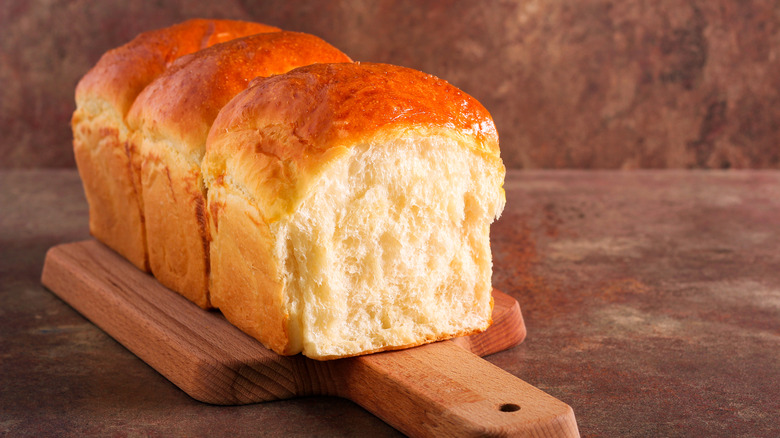The History Of Japanese-Style Milk Bread
Sourdough may have been the star of the stay-at-home years, but if you're a carb lover in America, recent history has been all about Japanese milk bread. An impossibly soft, rich take on sandwich bread that resembles American sliced white bread, Japanese milk bread crossed the Pacific in the 2010s, and has become a sensation at restaurants and bakeries. A staple in Japan for decades, milk bread is a dense, sweet bread that has spread with Asian bakery chains like Paris Baguette.
As a high-fat enriched bread that uses milk and an East Asian style of roux called tangzhong, it is eaten as a simple snack with toppings like jam, made into Japan's sweet fruit sandwiches, or occasionally as savory sandwiches with katsu or egg salad. And while its specific origins are not completely clear, it shows a true multi-cultural influence that mirrors the history of Japan. As a nation where rice was the primary grain for centuries, European-style bread was not introduced to Japan until the 16th century by Dutch and Portuguese traders.
The Japanese word for milk bread, "shokupan," even comes from the Portuguese base word, "pan." However, bread remained a rare product in Japan, and during the Edo Period that followed, Japan closed its doors to most trade and tried to limit outside influence on its culture. This kept bread tightly contained in the port of Nagasaki, which still allowed limited contact with the Dutch. It would take 200 more years for milk bread to appear.
Japanese milk bread was shaped by trade and war
In 1853, American commodore Matthew Perry sailed into the Tokyo Bay harbor and used American naval power to push the Japanese into a treaty that eventually reopened the country to Western trade. After this, immigrants moving to Japan started opening bakeries, and a possible early version of milk bread was created by British baker Robert Clarke, who founded Yokohama Bakery in 1862. While this is unconfirmed, bread did spread as the Meiji Era in Japan started embracing Western influence throughout society.
Tangzhong, the warm flour-and-water paste used to make milk bread, was already used to make springy Chinese-style steamed buns, so a combination with white bread at some point was only natural. Without bread ovens in most homes, it was mostly a treat, not a staple. This changed after World War II. The destruction of Japan's defeat made rice much more scarce, and as the occupying force, the United States was left with the job of relief.
This meant that wheat from the bread-eating country started replacing rice in the 1950s. While rice stayed the country's staple grain, milk bread became even more popular as the rise of convenience stores spread sandwiches through Japan. Everything came full circle as stores like Japan's Mitsuwa and Taiwan's 85 Degrees C embraced mass-produced milk bread and started spreading it around the world. Now, milk bread is conquering the very places that brought bread to Japan, and we all get to enjoy this delicious blending of East and West.

